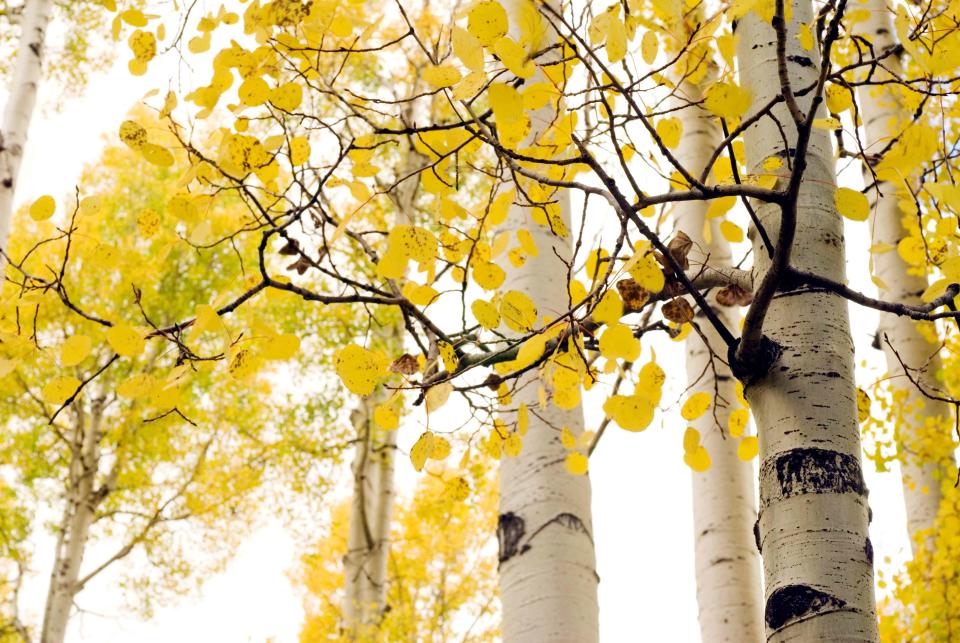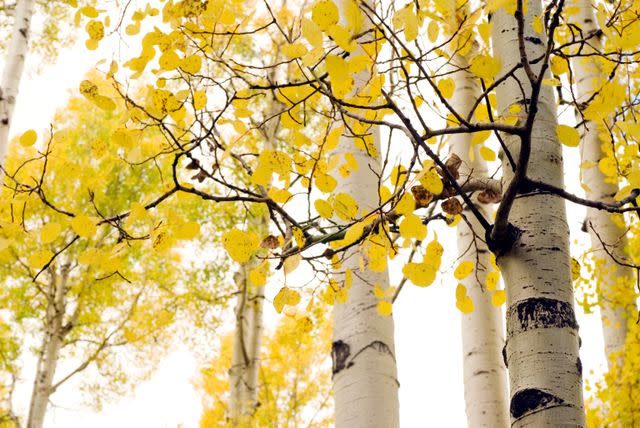How to Plant and Grow Poplar Trees
Straightforward details about planting and growing several types of poplar trees.

SageElyse / Getty Images
A native tree species found in nearly every state in the Union, poplar trees (Populus spp.) are usually best grown in their native habitat. When planted in urban and suburban landscapes, far removed from the nuances of their native habitats, poplar trees languish. In these modified environments, they are short-lived, messy trees with brittle wood that creates frequent litter. Familiar types of poplar trees include quaking aspen, big tooth aspen, eastern cottonwood, white poplar, black poplar, and Lombardy poplar. All members of the same genus, these poplar trees share several traits.

SageElyse / Getty Images
Quaking aspen trees are some of the best-known poplar trees and for good reason. Their striking white bark, strong vertical habit, and magnificent fall color add beauty and interest to the landscape. Plant breeders have worked to select cultivars of quaking aspen that can stand up to the rigors of a residential landscape. Several cultivars are available, and when planted in the right spot, they thrive. Eastern cottonwood is another common poplar. A massive tree that tops out at more than 100 feet tall, eastern cottonwood tolerates wet soil and is often found near streams and rivers in its native habitat. Eastern cottonwood, like many poplars, is not a good choice for urban and suburban landscapes.
Where to Plant Poplar Trees
Poplar trees grow well in full sun or part shade. The tree needs at least six hours of direct sunlight a day to develop a strong branching structure. Poplars are prized for their ability to grow in a wide range of soils, from loamy sand to clay. From quaking aspens to eastern cottonwoods, poplar trees grow best in their native habitats. The disturbed soil and irregular growing conditions in urban and suburban areas aren’t suitable for them. They are generally short-lived in residential areas, and those that survive for decades tend to have weak wood and frequently drop branches and limbs.
Invasive Plants
Not every poplar tree is invasive in the United States, but many are invasive in specific states—some are severely invasive. Check with a horticultural expert in your area before ordering or planting one of the many poplar tree species.
How and When to Plant Poplar Trees
Plant a poplar tree in spring as soon as the soil can be worked. Dig a planting hole only a few inches wider than the tree’s rootball. When the tree is placed in the planting hole, the top of the rootball should be level with the surrounding grade. Backfill the planting hole with native soil and build a shallow basin around the root zone. Water the tree by providing about 10 gallons of water once a week. Continue watering regularly through the first growing season.
Related: These Are the Tools BHG Garden Editors Recommend for Beginners and Pros Alike—All at Amazon
Poplar Tree Care Tips
Light
Poplar grows best in full sun or part shade. Choose a planting spot that receives at least six hours of direct sunlight a day.
Soil and Water
Poplar grows in a wide variety of soil conditions. It will thrive in fast-draining, sandy loam and slow-draining clay. Most poplars grow best in areas that receive regular moisture. Some types of poplar tolerate dry spells.
Temperature and Humidity
Temperature and humidity preferences for poplar trees vary by type. Quaking aspens, for example, languish in heat and humidity. They are at home in cool, mountainous areas. Eastern cottonwood, on the other hand, grows well in heat and humidity and tolerates intense summer conditions.
Fertilizer
Poplar trees do not require fertilization. They mine the soil for nutrients and grow quickly without fertilizer.
Pruning
Prune poplar trees in spring or whenever dead or broken branches are noticed. A weak-wooded tree, poplar often drops branches and entire limbs after a strong storm. It is not uncommon to find the turf under a poplar tree littered with twigs and branches in spring after a typical winter.
Pests and Problems
Rabbits and deer frequently browse young poplar trees. Protect young trees with a wire mesh barrier, especially in the winter. Insect pests include borers, aphids, caterpillars, and scales.
Several types of poplar trees produce vigorous seedlings that can quickly become a nuisance. Have a plan in place to deal with seedling trees; herbicides are generally ineffective, and hand-pulling is often required.
Types of Poplar Trees
There are about 35 species of poplar trees, but most are not particularly desirable in the home landscape.
Eastern Cottonwood
Eastern cottonwood (Populus deltoides) is a large, fast-growing tree usually found along streams and riverbanks in its native environment. It grows 100 feet tall and is also known as Carolina poplar or simply poplar. Eastern cottonwood produces copious amounts of seed each spring. The seeds are attached to silky white hairs and dispersed by the wind. A rampant reseeding tree, eastern cottonwood seedlings can become a nuisance. Like other members of the poplar family, eastern cottonwood has brittle wood and frequently drops branches. It is plagued by a variety of pests and diseases. It is not a good tree for urban or suburban landscapes. Zones 3–9.
European Aspen
Similar to quaking aspen, European aspen (Populus tremula) has heart-shaped or triangular leaves that shimmer in the slightest breeze. It has smooth gray bark. Look for tall and narrow ‘Erecta’ European aspen. This 40-foot-tall and 7-foot-wide selection is fruitless—it does not produce seeds. Zone 2–9.
Fremont Cottonwood
Native to the western United States, Fremont cottonwood (Populus fermontii) is common near streams in dry desert lands. Like other members of the poplar family, it is weedy and not useful in home landscapes. Zones 5–9.
Quaking Aspen
Quaking aspen (Populus tremuloides) is at home in cool mountain regions. It is known for its outstanding yellow fall color, white bark, and leaves that quake in the slightest breeze. It is useful in the garden as a fast-growing windbreak. It does not tolerate heat and humidity and grows best in well-drained soil. It grows 40 to 50 feet tall and 20 to 30 feet wide. Zones 2–6.
White Poplar
White poplar (Populus alba), also known as silver poplar, is a European introduction that has naturalized in some areas of North America where it is deemed weedy or invasive. Brittle wood, aggressive reseeding, and weak tree structure make it a poor landscape tree. Zones 3–9.
Frequently Asked Questions
Where is the best place to plant quaking aspen?
Quaking aspen thrives in cool mountain regions. Plant it in rocky soils at high mountain elevations or sandy loam soil at lower elevations. It is hardy in Zones 2–6.
How fast do poplar trees grow?
Exceptionally fast! Quaking aspens, for example, are known to increase their height by 24 inches or more a year when they are planted in a hospitable location.
When is the best time to prune poplar trees?
Prune poplars in spring before new growth emerges. The leafless branches make it easy to see the tree’s structure. Don’t hesitate to prune away broken or diseased branches any time of the year.
For more Better Homes & Gardens news, make sure to sign up for our newsletter!
Read the original article on Better Homes & Gardens.

